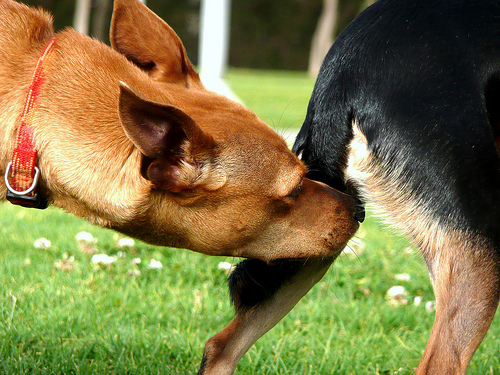Why Dogs Smell Other Dog Butts
You know the scene: you're out with your dog when you come across another friendly canine. There's the initial sniff, and a circle around. Now, another moment and another sniff, right on the rear end. Then it's time for another loop around and yet another butt sniff. Why do dogs do this?
As a pet owner, the natural thing is to want to pull your dog away from the other dog when they are performing this ritual. After all, it is a little embarrassing when your dog starts smelling the butt of a friend or neighbor's dog while you are having a conversation.
It seems pretty weird, especially considering how humans communicate, but it's actually an important part of canine behavior. Here's why.
Butt sniffing is a very natural, instinctual, and basic form of dog-to-dog communication. Strangely enough, it is how dogs greet and get to know each other. Even dogs that know each other will sniff butts to “see what's new” and reinforce their bond and communication.
The dog butt sniff is the canine equivalent of “hello, how do you do?” and similar to how humans use a handshake when meeting and being introduced to someone. Dogs communicate with each other using their strong sense of smell and detect signals in the chemicals in smelly oil from the anal glands.
What a Dog Sniff Can Reveal About Another Dog
 To understand what a sniff can tell a dog, it is important to understand how dogs are different. There are four main differences in the ways that dogs communicate in comparison with human communication.
To understand what a sniff can tell a dog, it is important to understand how dogs are different. There are four main differences in the ways that dogs communicate in comparison with human communication.- The first difference between dogs and humans is a dog's amazing sense of smell. They are reported to have approximately 40 times more smell-sensing cells in their nasal passages than we do (and some reports suggest an ability as much as 1,000 to 100,000 times greater than that of humans). With such a super ability to smell, dogs rely on this sensory information far more than humans. Some experts believe it consumes over 30% of a dog's brain function as opposed to about 5% in humans. It's so strong that a dog entering a room can perceive if another dog previously in the room was happy, stressed, scared, or in heat. Although it is difficult for humans to completely understand exactly how this works, the “sniff” can somehow also tell the dogs if the encounter is likely to be friendly or not friendly.
- Dogs have prominent and active anal glands. These apocrine glands, which sit on each side of a dog's rectum, produce strong-smelling secretions intended to send chemical signals about that dog's identity to other animals. These signals include information like the sex of the dog, what the dog is eating, and even some clues about a dog's emotional state.
- The third difference of note is the presence of the Jacobson's organ (also known as the vomeronasal organ). This is a small piece of olfactory nerve tissue filled with extrasensory receptors that perceives odors transmitted through the air. Also present in many animals including cats, snakes, and even elephants, it transmits information to the brain from its position just inside the nose and mouth. You might notice a dog is activating their Jacobson's organ when they make a funny face called the "Flehman response." Dogs will often tilt their nose up and curl their lip to optimize their ability to "smell" in this way.
- The last big difference is that unlike humans, dogs will reintroduce themselves frequently, sometimes several times in a day or even an hour. Any change or stimulus will often lead to the butt sniff. Some believe the “sniff” can actually relieve tension and stress by helping an individual feel more comfortable about the other dog. Two dogs living in the same house may smell each other when one comes in from the outside or comes back from the vet to confirm information about the dog's state including diet, stress, availability for mating, and mood.
What You Should Do During Dog to Dog Butt Sniffing
Behaviorists suggest that because the butt sniffing routine is a normal part of dog behavior, it's best not to interrupt it if the dogs seem friendly. Interrupting this behavior is equivalent to you stopping a friend from shaking hands with someone they are meeting: it can annoy or upset the friend and can make the introduction awkward. In fact, lack of this butt sniffing communication between dogs can create stress between the dogs.
With that being said, some dogs are more aggressive "sniffers" than other dogs and not every dog that meets will actually like each other. If the sniffing gets intense and you notice any other signs of aggression, then it is appropriate to pull your dog away from the other.




Comments
Post a Comment